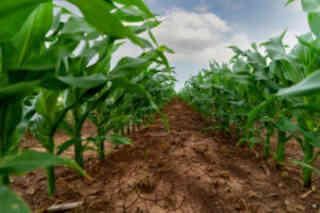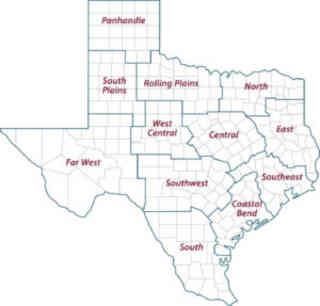By Adam Russell
Corn acres are expected to increase nationally this season, while planted acres in Texas are expected to decline, according to a Texas A&M AgriLife Extension Service expert.

Much of Texas continues to experience significant drought conditions, which may be impacting planting decisions. Texas corn acres are expected to be 100,000 acres below last year’s total of 2.15 million acres, said Mark Welch, Ph.D., AgriLife Extension grain economist, Bryan-College Station.
Welch said the U.S. Department of Agriculture prospective plantings survey estimated growers nationwide would plant 92 million acres of corn. That number is 3.4 million above last year’s planted corn acres.
The additional prospective corn acres are spread across the country with an increase of 865,000 across the South, 950,000 acres in the Dakotas, 650,000 acres in Iowa, Illinois and Indiana, and another 550,000 acres in other Corn Belt states.
In some areas, there are questions surrounding final planting decisions due to weather, Welch said. Corn plantings in some parts of the Corn Belt states are still in doubt due to drought, and the near 1 million acres in North Dakota and South Dakota may be delayed due to a cold, wet spring.
Corn Belt states like Nebraska and Kansas that have been locked in exceptional and extreme drought received rainfall recently, and planting conditions were expected to improve if El Niño weather patterns deliver more rain. Growers in the Dakotas can typically plant corn into June, but a late spring snow melt and subsequent soggy conditions could push farmers to other crops like soybeans.
“As we get into May, the grain markets will be paying attention to the areas where there are questions about whether they actually get significant corn acreage planted,” Welch said.
Good prices push U.S. corn acres upward
The drought may keep Texas acres down, but the price incentive to plant corn is driving the increase in acres nationally, Welch said. However, there is a concern that good yields across the nation could drive prices down.
All grain prices have fallen in recent weeks, Welch said. But the fall is not confined to the grain markets. Other commodities like crude oil and copper are down as well, reflecting weakness in the overall outlook for the economy.
Corn futures prices remain relatively strong at $5.25 per bushel, but that is down from $5.75 a bushel a month ago and $7.45 a bushel at this time last year, he said. El Niño weather patterns are generally associated with good growing conditions in the Corn Belt, and Welch expects growers to realize 179 bushels per acre or better, which would mean record yields.
“Grain prices have really been under pressure the last 10 days or so,” Welch said. “Overall, yield outlooks are very positive, but the impact of a slowing economy and higher interest rates are playing into commodity markets. The use side is where the challenge will be if yields create a glut of corn.”
Welch said there is still good demand for grains now, and stored corn supplies are tightening. That could mean good cash prices for Texas producers who get their crop to harvest in July and August because they are typically among the first to enter the grain market each season.
However, Brazil has a big corn crop that will be harvested around the same time and could counter-balance that advantage on a global scale, especially with exports to China, he said.
“It seems like there is a lot of last-second decision-making around the state and in some areas of the country with significant acres that could go to one crop or the other,” he said. “It will be interesting to see which way everything goes and how the season plays out from now to harvest.”
AgriLife Extension district reporters compiled the following summaries:

CENTRAL
Some severe weather was reported with rain totals ranging from 0.5-2.5 inches. Soil moisture was adequate to short. There were reports of large, severe hail and damaging winds. Soil moisture levels and crop conditions improved. Temperatures were mild in the morning but warm in the afternoons. The pasture and land conditions were muddy following the rain but dried up quickly. Herbicide and fertilizer applications began in some areas and were wrapping up in others. Weeds, including sandburs and dodder, were prevalent. Dairymen were chopping silage. Corn and sorghum looked good to excellent. Some cotton was yet to be planted due to the wet conditions. Wheat progressed nicely thanks to moisture and warm daytime temperatures. Fields with significant Hessian fly damage were being assessed. Warmer conditions and improving pastures resulted in a stronger calf market. Rangeland and pasture ratings were poor to excellent. Supplemental feeding was very low as warm-season grasses responded to weather. Spring cattle work continued, and livestock were in good condition.
ROLLING PLAINS
Most of the district received rain and cooler temperatures. Almost all areas reported rain totals from 0.5-3.5 inches. The rain should jump start spring pasture grass growth, but much more rain will be needed to sustain pasture growth and fill livestock tanks. More rain was needed for soil preparation for cotton planting.
COASTAL BEND
Rainfall of 1-2.5 inches was reported throughout the district. Many fields were saturated with rain. Hailstorms were reported and crop damage was being assessed. One farmer may have lost as much as 80% of his corn crop. Corn fields around the district responded to the moisture and cooler weather and looked good except for areas with standing water. Corn was starting to tassel, and some was in the silk stage. Later-planted corn and sorghum looked good; however, stands were not as consistent as the early planted fields. Grain sorghum looked good and was starting to head out. Continued rain showers last week impacted numerous cotton fields, with several acres lost due to flooding. Cotton growth slowed but was expected to pick up with sunny days and higher temperatures in the forecast. Sorghum fields started to flag and many acres should start flowering soon. Rainfall helped recently emerged rice. Leaf smut was reported in wheat, but fungicide treatment was not necessary yet. Wheat harvest should begin in two weeks with warmer, drier days. Pasture conditions improved dramatically with moisture, and the first cuttings of hay were harvested except where delayed by recent rains. Ponds continued to gather water and some were full. Cattle herds were in good to excellent condition and calves were gaining weight and looked good. Livestock prices were still at historic highs.
EAST
Heavy rain fell over much of the district. Subsoil and topsoil conditions were adequate to surplus. Some hail was reported. Houston and Rusk counties reported hail damage to barns, trees and crops. High winds and flash flooding damaged ryegrass fields. Wet conditions continued to slow down farming operations. Pasture and rangeland conditions were fair to good. Cool nighttime temperatures kept warm season grasses and spring vegetables from growing at a normal pace. Producers struggled to cut and bale hay between rain events. Livestock were in fair to good condition with some supplementation taking place. Cattle prices were steady overall. Prices were lower for lightweight cattle while heavier cattle prices remained firm. Horn fly and gnat populations increased.
SOUTH PLAINS
Some counties received much-needed rain. Rain totals ranged from trace amounts up to 1.75 inches. Tennis ball-sized hail was reported in one area. Farmers were spraying wheat to prepare the ground for cotton planting. Producers were struggling to irrigate enough. Some winter wheat was being harvested for hay.
PANHANDLE
Much of the area received some moisture, from traces to almost 2 inches, but much more rain was needed to break the drought. Daytime temperatures were unseasonably cool, averaging only 62-68 degrees. The moisture was timely for small grain crops approaching the heading stage. Most dryland wheat fields failed. Some producers were moving cattle to wheat in hopes of grazing it. Farmers continued to prepare fields for summer crops and recent rainfall helped increase the soil moisture profile. Some corn was planted but needed moisture to emerge. Cotton planting was on hold, with some acres of cotton expected to go to another crop. Pastures and rangeland benefited from the rain and grass looked better each day. Livestock were in good condition with very little supplemental feeding.
NORTH
Pasture and rangeland conditions were fair to good. Temperatures were cooler. Night temperatures dropped into the mid-40s, and daytime temperatures were mostly in the 60s. Some counties received 3-6 inches of rain. Wheat crop conditions were improving with the moisture and maturing. Corn and sorghum were progressing in good to excellent condition. Livestock were in good condition. Some horn and stable fly populations were reaching nuisance levels.
SOUTHEAST
Consistent rains over the last couple of weeks allowed good moisture collection in the soil. There were reports of up to 1.5 inches of rain. Soil moisture levels were adequate to surplus. Temperatures were warmer, but nights remained cool. Warm-season forages were growing well, and cool-season weeds were fading. Some producers made their first hay cuttings. Several fields with ryegrass were cut and baled. Calf prices remained firm. Runoff from the rains filled ponds and streams. Rice planting and growth in planted fields were delayed by wet, cool weather. Corn was in excellent condition.
SOUTHWEST
The rainfall was spotty, and conditions were windy, cloudy and cool. Heavy hail caused some crop damage. Grazing conditions were improving in pastures and rangeland. Dryland crop conditions improved as well. Row crops looked good, and some producers were starting to harvest wheat. Rust was in the wheat and producers were spraying. Gardens looked good where irrigated. Creek water levels were dropping. Spring shearing continued. Livestock markets were high on cattle and average to slightly low on sheep and goats. Higher volumes of cattle were going to market. Livestock were in mostly fair condition and received supplemental feed.
SOUTH
Wheat and oat crops continued to mature or dry down, and field preparations for harvest were underway. Corn crops continued to develop. Cotton crop planting should be complete soon. Farmers were preparing for peanut planting. Supplemental feeding continued for all livestock. Brush was growing new leaves and blooming. Row crop farmers were preparing to spray and cultivate fields. Hay fields were reaching maturity and producers anticipated a good first cut. Forages in pastures and rangelands showed notable growth, and grazing availability improved significantly. However, rangelands and pastures were still in poor condition in some areas. Cattle body condition scores were improving along with grazing. Local beef cattle markets reported below normal sale volumes. Cotton growers were spraying weeds and fertilizing. Grain sorghum looked excellent with very little sugarcane aphid pressure. Corn looked good with many fields past the silking stage. Sesame was in the early growth stages and looked good. Sunflowers were blooming and appeared to be insect-free.
Source : tamu.edu